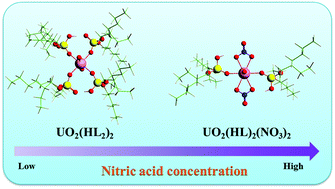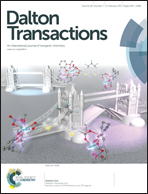Theoretical studies on the AnO2n+ (An = U, Np; n = 1, 2) complexes with di-(2-ethylhexyl)phosphoric acid†
Abstract
Actinide separation in spent nuclear fuel reprocessing is essential for the closed nuclear fuel cycle. Organophosphorus reagents have been found to exhibit strong affinities for actinides in experiments. In this work, the extraction complexes of AnO2n+ (An = U, Np; n = 1, 2) with the traditional organophosphorus ligand HDEHP (di-(2-ethylhexyl)phosphoric acid) have been investigated using density functional theory together with scalar-relativistic effective core potentials (ECPs) for actinide elements. According to our calculations, the HDEHP dimer prefers to act as a bidentate ligand in most of the studied complexes. HDEHP ligands show a higher extraction ability for An(VI) over An(V), and the formation of Np(VI) complexes is slightly more favorable than those of U(VI) analogues, which is mainly attributed to the stronger donor–acceptor interaction in Np(VI) complexes. The intramolecular hydrogen bonds play a significant role in the stability of the 1 : 1 type complexes AnO2(HL)2(NO3)2 (L = DEHP−). Moreover, AnO2(HL)2(NO3)2 are the most stable species in nitrate-rich acid solutions, while at low nitric acid concentrations, the complexing reaction of AnO2(H2O)52+ + 2(HL)2 → AnO2(HL2)2 + 2H+ + 5H2O is probably the dominant reaction in the extraction process. Our results can help to understand the speciation of actinyl complexes in real solvent extraction of actinides with HDEHP at the molecular level.


 Please wait while we load your content...
Please wait while we load your content...